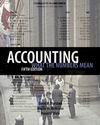 |  Accounting: What the Numbers Mean, 5/e David H. Marshall,
Millikin University
Wayne W. McManus,
International College of the Cayman Islands
Daniel F. Viele,
Webster University
Cost Accounting and Reporting Systems
Chapter 13 Learning ObjectivesAfter studying this chapter, you should understand:
1.The role of cost accounting as it relates to financial and managerial accounting. |
 |  |  | 2.How cost management plays a strategic role in the organization's value chain. |
 |  |  | 3.The difference between direct and indirect costs and how they relate to a product or activity. |
 |  |  | 4.The difference between product costs and period costs, and the three components of product cost. |
 |  |  | 5.The general operation of a product costing system and how costs flow through the inventory accounts to cost of goods sold. |
 |  |  | 6.How predetermined overhead application rates are developed and used. |
 |  |  | 7.The presentation and interpretation of a statement of cost of goods manufactured. |
 |  |  | 8.The difference between absorption and direct (or variable) costing. |
 |  |  | 9.Activity-based costing and activity-based management. |
|


 2002 McGraw-Hill Higher Education
2002 McGraw-Hill Higher Education